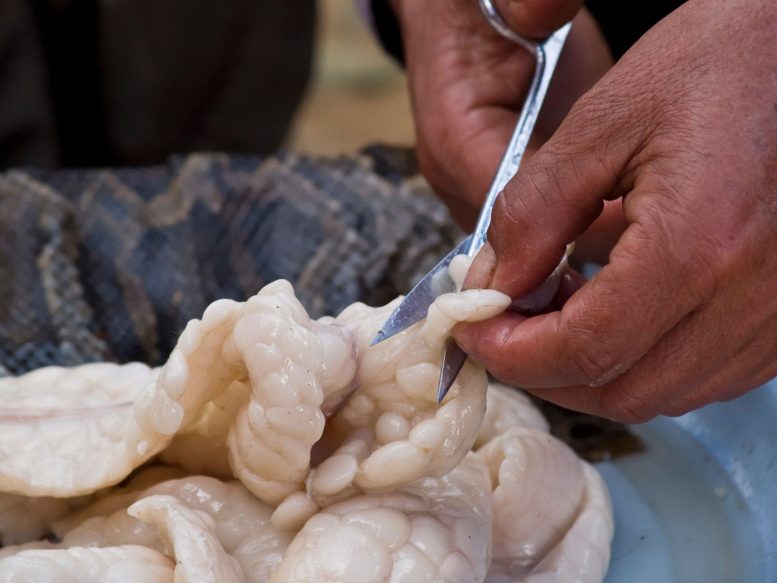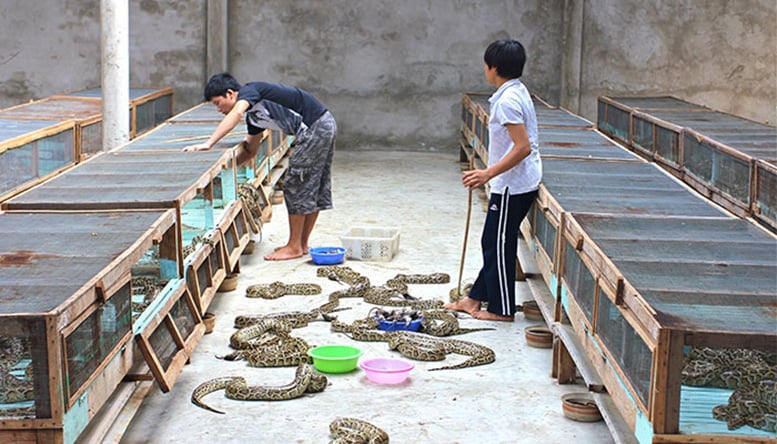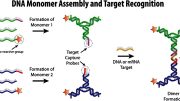
A study shows that pythons could be a highly efficient and sustainable alternative to traditional livestock, rapidly converting feed to body mass and thriving on minimal resources, offering a potential solution to global food insecurity.
New research has revealed that pythons are an efficient, low-emission, and climate-resilient source of food, demonstrating superior feed-to-protein conversion rates compared to chickens or cattle.
New research published in Scientific Reports conducted in two South-East Asian commercial python farms led by Honorary Research Fellow Dr. Daniel Natusch from Macquarie University’s School of Natural Sciences, found pythons convert feed into weight gain remarkably efficiently compared to conventional livestock such as chickens and cattle.
“In terms of food and protein conversion ratios, pythons outperform all mainstream agricultural species studied to date,” Dr. Natusch says.
“We found pythons grew rapidly to reach ‘slaughter weight’ within their first year after hatching.”
Snake meat is white and very high in protein, Dr. Natusch says.
The multi-institutional research team included scientists from Australia’s Macquarie University and University of Adelaide, the UK’s University of Oxford, South Africa’s University of the Witwatersrand, and the Vietnamese Academy of Science and Technology in Hanoi.
The researchers compared reticulated pythons (Malayopython reticulatus) and Burmese pythons (Python bivittatus) farmed at commercial python farms in Thailand and Vietnam, testing the effects of different food regimes.

Lead author Dr. Dan Natusch handles an Australian water python, one of 39 different python species. Credit: Derek Henderson
Flexible solution for food insecurity
“Climate change, disease, and diminishing natural resources are all ramping up pressure on conventional livestock and plant crops, with dire effects on many people in low-income countries already suffering acute protein deficiency,” says Dr. Natusch.
Failures in conventional agrifood systems leading to widespread food insecurity is driving interest in alternative food sources, he says. “Cold-blooded reptiles … are hugely more efficient at turning the food they eat into more flesh and body tissue than any warm-blooded creature ever could.”
Snake meat is a sustainable, high protein, low-saturated fat food source already widely consumed across Southeast Asia and China.

This research trialed different diets on groups of pythons, and found that pythons can achieve fast growth rates. Pictured: feeding trial in python farm Credit: Dan Natusch
“However, while large-scale python farming is well established in Asia, it has received little attention from mainstream agricultural scientists,” says Dr. Natusch. “Snakes require minimal water and can even live off the dew that settles on their scales in the morning. They need very little food and will eat rodents and other pests attacking food crops. And they were a delicacy, historically, in many places. Our study suggests python farming complementing existing livestock systems may offer a flexible and efficient response to global food insecurity.”
Costs and benefits
Co-author Professor Rick Shine, from Macquarie University’s School of Natural Sciences says this is the first study taking an in-depth look at the inputs and outputs, costs and benefits of commercial snake farms.
“There are clear economic and adaptability benefits to farmers who raise pythons rather than raising pigs,” Professor Shine says.
Snake farms are typically large barns surrounded by ‘sun traps’ for basking, which escape most of the complex animal welfare issues surrounding caged mammals and birds.
“Birds and mammals waste about 90 percent of the energy from the food they eat, simply maintaining a constant body temperature,” says Professor Shine. “But cold-blooded animals like reptiles just find a spot in the sun to get warm. They are hugely more efficient at turning the food they eat into more flesh and body tissue than any warm-blooded creature ever could.”
Hiding the broccoli
The research team trialed groups of pythons on different ‘sausages’ of waste protein from meat and fish off-cuts, and found intensive feeding of juveniles prompted fast growth rates with no apparent welfare impacts.
Despite pythons being solely carnivorous in the wild, they could digest soy and other vegetable protein, and some sausages included around ten percent vegetable protein, hidden among the meat.
“It’s a bit like hiding broccoli in the meatballs to get your kids to eat their veggies,” Dr. Natusch says. “We showed that snake farms can effectively convert a lot of agricultural waste into protein, while producing relatively little waste of their own.”
When processed, around 82 percent of a python’s live weight yields usable products, including the high protein dressed carcass for meat, the valuable skin for leather, and the fat (snake oil) and gall bladder (snake bile) which both have medicinal uses.
Kilo for kilo, reptiles produce far fewer greenhouse gases than mammals. Their sturdy digestive systems, which can even break down bone, produce almost no water waste and far less solid waste than mammals.
Pythons can fast for more than four months without losing much weight, and rapidly resume growth as soon as feed restarts, so consistent production can continue even when food is scarce,” says Dr. Natusch.
“We also found some farms outsource baby pythons to local villagers, often retired people who make extra income by feeding them on local rodents and scraps, then selling them back to the farm in a year.”
Professor Shine says this study shows the extraordinary efficiency of reptiles in turning waste into useable products, highlighting big opportunities in countries where there is already a cultural precedent for snake meat.
However, it’s unlikely that Australia or Europe will adopt python farming, he says.
“I think it will be a long time before you see Python burgers served up at your favorite local restaurant here.”
Reference: “Python farming as a flexible and efficient form of agricultural food security” by D. Natusch, P. W. Aust, C. Caraguel, P. L. Taggart, V. T. Ngo, G. J. Alexander, R. Shine and T. Coulson, 14 March 2024, Scientific Reports.
DOI: 10.1038/s41598-024-54874-4
The study was funded by the Python Conservation Partnership, the University of Witwatersrand Research Council, and the Carnegie Corporation of New York.










What do they do for feeding pythons ?
What kind of food do they use for feeding? Doesn’t creating those food costs biologically?
We should set up breeding and farming pens here in southern US. Imagine a program where all the rats in the inner cities are trapped and used for food. They can be shipped live or fresh frozen.
This is absolutely disgusting! Torturing and killing another animal species totally unnecessarily when one can always get adequate protein from a whole plant based diet as shown by Blue Zones communities around the world for hundreds of years.